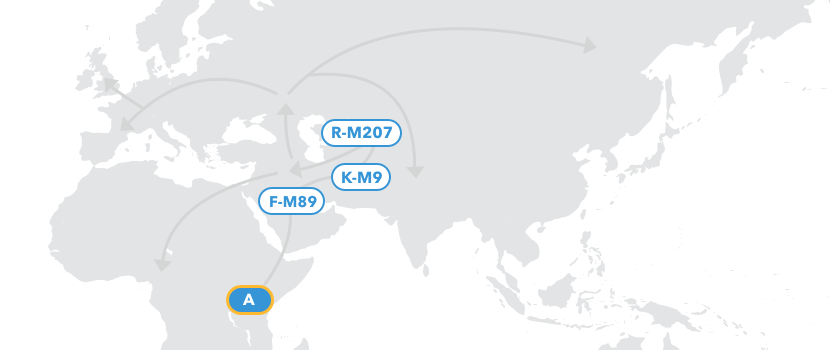The Chinappi men descend from a long line of men that can be traced back to eastern Africa over 275,000 years ago. These are the men of our paternal line, and our paternal haplogroup sheds light on their story.
The Chinappi paternal haplogroup is R-L2.
As our ancestors ventured out of eastern Africa, they branched off in diverse groups that crossed and recrossed the globe over tens of thousands of years. Some of their migrations can be traced through haplogroups, families of lineages that descend from a common ancestor. Your paternal haplogroup can reveal the path followed by the men of your paternal line.
This is how we find out
The Y Chromosome
Most of the DNA in your body is packaged into 23 pairs of chromosomes. The first 22 pairs are matching, meaning that they contain roughly the same DNA inherited from both parents. The 23rd pair is different because in men, the pair does not match. The chromosomes in this pair are known as “sex” chromosomes and they have different names: X and Y. Typically, women have two X chromosomes and men have one X and one Y.
Your genetic sex is determined by which sex chromosome you inherited from your father. If you are genetically male, you received a copy of your father’s Y chromosome along with a gene known as SRY (short for sex-determining region Y) that is important for male sexual development. If you are genetically female, you received a copy of the X chromosome from both of your parents.

Paternal Inheritance
Each generation, fathers pass down copies of their Y chromosomes to their sons essentially unchanged. Between generations, the matching chromosomes in the other 22 pairs make contact and exchange segments of DNA. This process shuffles the genetic information that is passed down from parent to child, making it difficult to trace genealogy over many generations. Except for two tiny sections at the chromosome’s tips, however, the Y skips this step. Instead, a nearly identical copy is handed down each time.
But, every so often, small changes to the DNA sequence do occur. These changes, called mutations, create new genetic variants on the Y chromosome. Because the Y does not recombine between generations, these variants collect in patterns that uniquely mark individual paternal lineages.

Paternal Haplogroup Tree
To trace the genetic history of paternal lineages, researchers compare the variants found in Y-DNA sequences from around the world. The result is a tree of Y chromosomes that shows how all paternal lines are related.
A paternal haplogroup is a cluster of branches on the tree that stem from a common male ancestor and share a particular set of variants. To keep track of all the branches, the major sections of the tree are named with one or more capital letters. Each haplogroup name starts with the letter of the major branch from which it stems and ends with the name of a variant that identifies a particular subgroup.Visit the scientific details to see your lineage in the tree of all paternal haplogroups.

Tracing Male Migrations
Because closely related haplogroups tend to share geographic roots, researchers can use the modern distributions of haplogroups around the world to trace major migrations, from the voyage to Australia over 40,000 years ago to the peopling of North and South America in the last 16,000 years.

You share a paternal-line ancestor with Niall of the Nine Hostages.
R-M269 common ancestor over 10 000 years ago

The Uí Néill Dynasty
The spread of haplogroup R-M269 in northern Ireland and Scotland was likely aided by men like Niall of the Nine Hostages. Perhaps more myth than man, Niall of the Nine Hostages is said to have been a King of Tara in northwestern Ireland in the late 4th century C.E. His name comes from a tale of nine hostages that he held from the regions he ruled over. Though the legendary stories of his life may have been invented hundreds of years after he died, genetic evidence suggests that the Uí Néill dynasty, whose name means “descendants of Niall,” did in fact trace back to just one man who bore a branch of haplogroup R-M269.
The Uí Néill ruled to various degrees as kings of Ireland from the 7th to the 11th century C.E. In the highly patriarchal society of medieval Ireland, their status allowed them to have outsized numbers of children and spread their paternal lineage each generation. In fact, researchers have estimated that between 2 and 3 million men with roots in north-west Ireland are paternal-line descendants of Niall.
Haplogroup A
275,000 Years Ago
The stories of all of our paternal lines can be traced back over 275,000 years to just one man: the common ancestor of haplogroup A. Current evidence suggests he was one of thousands of men who lived in eastern Africa at the time. However, while his male-line descendants passed down their Y chromosomes generation after generation, the lineages from the other men died out. Over time his lineage alone gave rise to all other haplogroups that exist today.

Origin and Migrations of Haplogroup R-M269
10,000 Years Ago
Your paternal line stems from a branch of R-M343 called R-M269, one of the most prolific paternal lineages across western Eurasia. R-M269 arose roughly 10,000 years ago, as the people of the Fertile Crescent domesticated plants and animals for the first time. Around 8,000 years ago, the first farmers and herders began to push east into Central Asia and north into the Caucasus Mountains. Some of them eventually reached the steppes above the Black and Caspian Seas. There, they lived as pastoral nomads, herding cattle and sheep across the grasslands, while their neighbors to the south developed yet another crucial technology in human history: bronze smelting. As bronze tools and weaponry spread north, a new steppe culture called the Yamnaya was born.
Around 5,000 years ago, perhaps triggered by a cold spell that made it difficult to feed their herds, Yamnaya men spilled east across Siberia and down into Central Asia. To the west, they pushed down into the Balkans and to central Europe, where they sought new pastures for their herds and metal deposits to support burgeoning Bronze Age commerce. Over time, their descendants spread from central Europe to the Atlantic coast, establishing new trade routes and an unprecedented level of cultural contact and exchange in western Europe.The men from the steppes also outcompeted the local men as they went; their success is demonstrated in the overwhelming dominance of the R-M269 lineage in Europe. Over 80% of men in Ireland and Wales carry the haplogroup, as do over 60% of men along the Atlantic Coast from Spain to France. The frequency of R-M269 gradually decreases to the east, falling to about 30% in Germany, 20% in Poland, and 10-15% in Greece and Turkey. The haplogroup connects all these men to still others in the Iranian Plateau and Central Asia, where between 5 and 10% of men also bear the lineage.
Your paternal haplogroup, R-L2, traces back to a man who lived less than 8,000 years ago.
That’s nearly 320.0 generations ago! What happened between then and now? As researchers and citizen scientists discover more about your haplogroup, new details may be added to the story of your paternal line.
R-L2 today is relatively common among 23andMe customers.
Today, you share your haplogroup with all the men who are paternal-line descendants of the common ancestor of R-L2, including other 23andMe customers.
*The source of this information is the 23andme account of the author of this website.

Hello. I’m interested in exploring my generic background and connect with people from my lineage. Thanks